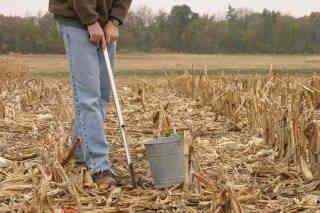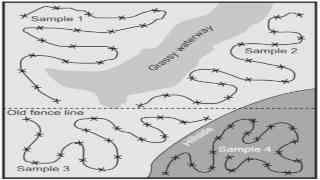The basics of sampling for SCN don’t change from year to year. The following guidelines are a repeat from last fall’s ICM News article reminding that fields should be sampled for the nematode.
Sampling guidelines
- Use a soil probe (Figure 1), not a spade, to collect soil cores.
- Collect 15 to 20 soil cores eight inches deep from every 20 acres.
- Collect multiple-core soil samples from management zones in the field, if possible (Figure 2).
- Combine the soil cores from a sampled area in a bucket, break up and mix the cores well, and then fill a soil sample bag with mixed the soil.
Where to send samples for processing
The Iowa State University Plant and Insect Diagnostic Clinic processes soil samples for SCN egg counts. The cost is $20 per sample for in-state samples and $25 per sample for out-of-state samples. The Nematode Sample Submission Form is available through the Extension Store and provides details about where to send the samples.
There also are numerous private soil testing laboratories in Iowa and surrounding states that process soil samples for SCN eggs. The SCN Coalition has a map of the names and locations of these labs online.
An Iowa State University Extension and Outreach publication, IPM 61, is available and provides guidance on how to interpret SCN soil sample results and compare results among different testing laboratories. Iowa State’s management recommendations based on soil sample egg counts in fields are available online also.
Managing SCN
Once a field is known to be infested with SCN, an integrated approach to manage the nematode is recommended. Farmers should grow SCN-resistant soybean varieties in rotation with nonhost crops, such as corn, and consider using nematode-protectant seed treatments on soybeans.
Soybean varieties with PI88788 resistance have lost much of their effectiveness in Iowa and surrounding states because SCN populations have become resistant to PI88788 resistance. Farmers should look for and grow resistant soybean varieties with the hard-to-find Peking resistance, which is very effective against SCN populations in most Iowa fields, providing high yields and suppressing nematode reproduction. There are not enough varieties with Peking SCN resistance for everyone to use, so farmers also should seek out and grow varieties with PI88788 resistance that provide high yields and good SCN control. Such information is available at Iowa State’s SCN-resistant Soybean Variety Trial Program website and may be available from other university and commercial information sources as well.
Additional information on SCN

Figure 1. Use a soil probe to collect 15 to 20 soil cores, 8 inches deep, from every 20 acres, then mix the cores in a bucket to comprise one sample.

Figure 2. Collect separate multiple-core soil samples from different management zones within a field to account for possible differences in SCN numbers among the areas of the field.
Source : iastate.edu